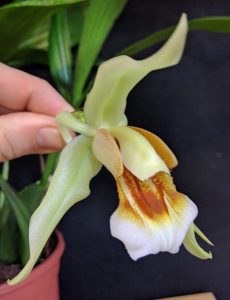As a genus, Coelogyne has relatively few registered hybrids, though nurseries like Orchideengarten Karge, in Dahlenburg, Germany, are working to redress this. Quite a few Coelogyne hybrids have been registered by them in the past few years, all bearing the name ‘Orchideengarten’ followed by a person’s name (it turns out that the Orchideengarten hybrids are all named after members of the Karge family). As an avid grower of Coelogyne, I have collected a number of these hybrids, and this month I present Coelogyne Orchideengarten Sabine.
This is a hybrid between Coelogyne speciosa and Coelogyne Mem. Willhelm Micholitz. As you would expect, C. speciosa is quite dominant, especially in terms of the flower. Vegetatively, however, it is almost exactly intermediate between its parents. Pseudobulbs are tall and stout, bearing one or two leaves which are narrower than in C. speciosa, but broader than in Mem. W. Micholitz. I should point out here that it is difficult to tell which trait has come from each parent, as there is no way of knowing which forms of C. speciosa and Micholitz were used to make the cross (my Mem. Wilhelm Micholitz is markedly different from that owned by a friend who got it from the same nursery – it seems likely then, that despite there being a clonal name on the label, the plants are all actually seed-grown). The whole plant displays a slightly ascending habit (with new growth being some half an inch higher than the previous growth), which is a trait I associate with C. lawrenceana, though less pronounced than in that species . Multiple new growths are frequently produced and the plant seems a good ‘clumper’
The flowers are produced sequentially from a slender, drooping inflorescence (the simultaneously flowering habit of C. mooreana has not found its way into the hybrid). The flowers very much resemble those of C. speciosa in shape and form. The colour, at first, is greenish white (very attractive), and fades to white as the flower ages. The lip bears a lovely orange splash. It has a slight fragrance. As beautiful as the blooms are, they are not well displayed compared to C. speciosa, as they appear too heavy for the inflorescence, and look odd on tall pseudobulbs. Also, the inflorescences have a tendency to concertina within the floral bracts and are prone to break unless I carefully remove the latter. Now this might be down to the clone of C. speciosa used, as I’ve observed some clones of C. speciosa that have that habit (though thankfully, none of my plants do). Having recently repotted this plant into a basket containing extra water-retentive medium, this has become less of a problem, so it might be due to insufficient water.
Overall, this is a beautiful hybrid that just misses the mark. Nevertheless, it will remain in my collection because despite all its quirks, I rather like it.
